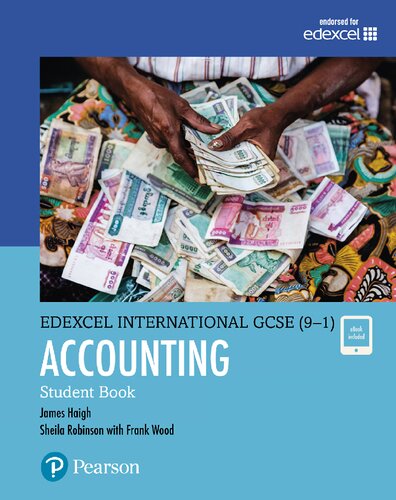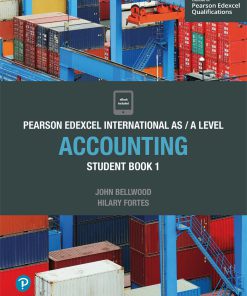Edexcel International GCSE 9 1 Accounting Student Book 1st Edition by James Haigh, Sheila Robinson ISBN 9780435189655 0435189654
$50.00 Original price was: $50.00.$25.00Current price is: $25.00.
Edexcel International GCSE 9 1 Accounting Student Book 1st Edition by James Haigh, Sheila Robinson – Ebook PDF Instant Download/Delivery: 9780435189655 ,0435189654
Full download Edexcel International GCSE 9 1 Accounting Student Book 1st Edition after payment

Product details:
ISBN 10: 0435189654
ISBN 13: 9780435189655
Author: James Haigh, Sheila Robinson
- Integrated exam practice throughout, with differentiated revision exercises, exam practice and learning summary sections.
- Provides free access to an ActiveBook, a digital version of the Student Book, which can be accessed online, anytime, anywhere supporting learning beyond the classroom.
- Transferable skills, needed for progression into higher education and employment, are signposted allowing students to understand, and engage with, the skills they’re gaining.
- A fully integrated Progression Map tool allows quick and easy formative assessment of student progress, linked to guidance on how to personalise learning solutions.
- Reviewed by a language specialist to ensure the book is written in a clear and accessible style for students whose first language may not be English.
- Glossary of key terminology.
Edexcel International GCSE 9 1 Accounting Student Book 1st Edition Table of contents:
Unit 1: The Accounting Environment
Chapter 1: Types of Business Organisation
1.1: Sole Trader
1.2: Partnership
1.3: Private Sector Organisations
1.4: Public Sector Organisations
Chapter 2: Use of Technology in Accounting
2.1: Introduction to Technology in Accounting
2.2: Functions of Accounting Software
2.3: Advantages and Disadvantages of Accounting Software
2.4: Data Loss
2.5: Security
Chapter 3: Professional Ethics and Introduction to Accounting Concepts
3.1: The Principles of Professional Ethics
3.2: Accounting Roles and Functions
3.3: Public Interest
3.4: Introduction to Accounting Concepts
Unit 2: Introduction to Bookkeeping
Chapter 4: Business Documentation
4.1: Introduction to Business Documentation
4.2: Purchase Order
4.3: Invoice
4.4: Credit Note
4.5: Statement of Account
4.6: Remittance Advice
4.7: Receipts
Chapter 5: Books of Original Entry
5.1: Books of Original Entry
5.2: The Ledgers
5.3: Classification of Accounts
5.4: Purchase Invoices
5.5: Cash and Credit Revenue
5.6: Purchase Returns (Returns Outwards) and Purchase Credit Notes
5.7: Sales Returns (Returns Inwards) and Purchase Returns (Returns Outwards)
5.8: Sales Returns (Returns Inwards) and Credit Notes
5.9: Cash Discounts
5.10: Bank Overdrafts and the Cash Book
5.11: The Journal
5.12: Writing up Journal Entries
Chapter 6: Ledger Accounting and Double Entry Bookkeeping
6.1: The Ledgers
6.2: Introduction and History of the Double Entry System of Accounting
6.3: The Double Entry System
6.4: Rules for Double Entry
6.5: The in and out Approach
6.6: T Accounts
6.7: Worked Examples: Cash Transactions
6.8: Introduction to Credit Transactions
6.9: Purchase of Inventory on Credit
6.10: Revenue of Inventory on Credit
6.11: Returns
6.12: Expenses on Credit
6.13: Worked Example
6.14: Revenue and Purchases
6.15: Comparison of Cash and Credit Transactions for Purchases and Revenue
6.16: Balancing the Accounts
6.17: Three-Column Accounts
6.18: Worked Example
6.19: Errors not Revealed by the Double Entry System
Chapter 7: Depreciation
7.1: Causes of Depreciation
7.2: Methods of Calculating Depreciation Charges
7.3: Recording Depreciation
7.4: The Disposal of a Non-Current Asset
Unit 3: Introduction to Control Processes
Chapter 8: Trial Balance
8.1: Balancing off
8.2: The Trial Balance
8.3: Worked Example
8.4: Steps to Take if the Trial Balance does not Balance
Chapter 9: Correction of Errors
9.1: Errors not Revealed by a Trial Balance
9.2: Errors not Affecting Trial Balance Agreement
9.3: Errors Affecting Trial Balance Agreement
Chapter 10: Control Accounts
10.1: The Principle of Control Accounts
10.2: Example: A Trade Receivables Ledger Control Account
10.3: Information for Control Accounts
10.4: Further Examples
10.5: Other Transfers
10.6: Control Accounts and Computerised Accounting Systems
10.7: Advantages of Control Accounts
10.8: Disadvantages of Control Accounts
Chapter 11: Bank Reconciliation Statements
11.1: Introduction to Recording Transactions
11.2: Reasons for Different Balances
11.3: Updating the Cash Book before Attempting a Reconciliation
11.4: Bank Overdrafts
11.5: Dishonoured Cheques
11.6: Other Reasons for Differences in the Balances
Unit 4: The Preparation of Financial Statements and end of Period Adjustments
Chapter 12: Capital and Revenue Expenditure
12.1: Capital Expenditure
12.2: Revenue Expenditure
12.3: Difference between Equity and Revenue Expenditure
12.4: Incorrect Treatment of Expenditure
Chapter 13: Accounting Concepts
13.1: Definition of Accounting Concepts
13.2: Fundamental Accounting Concepts
Chapter 14: Financial Statements of a Sole Trader
14.1: Introduction to the Income Statement
14.2: Uses of the Income Statement
14.3: Preparation of an Income Statement
14.4: Definition and Content of a Statement of Financial Position
14.5: Layout of the Statement of Financial Position Layout
Chapter 15: Other Receivables and Payables
15.1: Adjustments needed for Expenses Owing and Expenses paid in Advance
15.2: Other Payables
15.3: Other Receivables
15.4: Adjustment for Inventory of Stationery etc. Carried Forward
15.5: Revenue Owing at the end of Period
15.6: Expenses and Revenue Account Balances and the Statement of Financial Position
15.7: Worked Example: Financial Statements for a Sole Trader
15.8: Step-By-Step Guide: Dealing with Further Adjustments to Financial Statements
Chapter 16: Irrecoverable Debts
16.1: Irrecoverable Debts
16.2: Allowance for Irrecoverable Debt
Chapter 17: Incomplete Records
17.1: Preparing Financial Statements from Incomplete Records
17.2: Step-By-Step Guide: Incomplete Records
17.3: Incomplete Records and Missing Figures
Chapter 18: The Calculation and Interpretation of Accounting Ratios
18.1: Profitability and Liquidity
18.2: Profitability Ratios
18.3: Liquidity Ratios
18.4: Definition of Working Capital
18.5: Worked Example: Calculating Ratios
18.6: Limitations of Ratios
Chapter 19: Financial Statements of a Partnership
19.1: The Need for Partnerships
19.2: Limited Partners
19.3: Nature of a Partnership
19.4: Where no Partnership Agreement Exists
19.5: The Financial Statements
19.6: Worked Example: Appropriation Account
19.7: Current Accounts
Chapter 20: Financial Statements of a Manufacturer
20.1: Direct and Indirect Costs
20.2: Format of Financial Statements
20.3: Worked Example: A Manufacturing Account
Glossary
Accounting Standards Terminology
Index
People also search for Edexcel International GCSE 9 1 Accounting Student Book 1st Edition:
pearson edexcel international gcse past papers
pearson edexcel international gcse english anthology
pearson edexcel international gcse maths past papers
pearson edexcel international gcse 9-1 physics answers
pearson edexcel international gcse timetable 2025
Tags: James Haigh, Sheila Robinson, Edexcel International, Accounting, Student Book
You may also like…
Education Studies & Teaching - Studying & Test Preparation
My Revision Notes: Pearson Edexcel International GCSE (9–1) History Alec Fisher
Education Studies & Teaching - School Education & Teaching
Pearson Edexcel International GCSE (9-1) Business Student Book 1st Edition Rob Jones
Languages - English as a Foreign Language & Reference
Pearson Edexcel International GCSE 9 1 English Language A Student Book 2nd Edition Pam Taylor
Education Studies & Teaching - School Education & Teaching
Pearson Edexcel International GCSE (9-1) Economics Student Book 1st Edition Rob Jones
Computers - Computer Science
Pearson Edexcel International GCSE (9–1) Computer Science Student Book 1st Edition Ann Weidmann
Business & Economics - Accounting
Education Studies & Teaching - Studying & Test Preparation











